Samsung SM-T700 User Manual

SM-T700
User Manual
English (EU). 07/2014. Rev.1.1 |
www.samsung.com |
Table of Contents
Read me first |
Network connectivity |
||
|
|
37 |
Wi-Fi |
Getting started |
38 |
Internet |
|
|
|
||
7 |
Package contents |
Motions & usability features |
|
8 |
Device layout |
||
10 |
Charging the battery |
41 |
Motions |
12 |
Using a memory card |
43 |
Multi window |
14 |
Turning the device on and off |
48 |
Toolbox |
15 |
Locking and unlocking the screen |
48 |
Increasing touch screen sensitivity |
Basics |
Personalising |
|||
16 |
Using the touch screen |
49 |
Managing the Home and Apps screens |
|
20 |
Home screen layout |
55 |
Setting wallpaper and ringtones |
|
23 |
Notifications and quick setting panels |
56 |
Changing the screen lock method |
|
26 |
Opening apps |
57 |
Finger Scanner |
|
27 |
Installing or uninstalling apps |
61 |
Private mode |
|
29 |
Entering text |
62 |
Multiple users |
|
31 |
Screen capture |
64 |
Transferring data from your previous |
|
32 |
My Files |
|
device |
|
65 |
Setting up accounts |
|||
34 |
Power saving feature |
|||
|
|
|||
36 |
Viewing help information |
|
|
|
2

Table of Contents
Contacts
66Adding contacts
67Managing contacts
Camera
70 Basic shooting
73 Shooting modes
77 Camera settings
Gallery
79 Viewing photos or videos
82 Editing photos or videos
87 Gallery settings
Multimedia
88 Music
91 Video
Useful apps and features
93 Kids Mode
96S Finder
97S Planner
100S Voice
102Email
104Calculator
105Clock
106WatchON
109WebEx
120Businessweek+
121Dropbox
122Evernote
123Flipboard
124Hancom Office Viewer
129NYTimes
130Google apps
Connecting with other devices
132 Bluetooth
134 Wi-Fi Direct
136 Quick Connect
138 SideSync 3.0
145 Remote PC
150 Screen Mirroring
152 Mobile printing
Device & data manager
153Upgrading the device
154Transferring files between the device and a computer
155Backing up and restoring data
156Performing a data reset
3

Table of Contents
Settings |
Troubleshooting |
|
157 |
About Settings |
|
157 |
Connections |
|
160 |
Device |
|
166 |
General |
|
172 |
Applications |
|
Accessibility
177About Accessibility
178Using the Home button to open accessibility menus
178 Voice feedback (TalkBack)
189Changing the font size
189Magnifying the screen
189Setting notification reminders
190Reversing the display colours
190Colour adjustment
191Setting flash notification
191Turning off all sounds
191Caption settings
192Adjusting the sound balance
192Mono audio
193Assistant menu
195Setting tap and hold delay options
195Interaction control
196Using single tap mode
196Managing accessibility settings
197Using other useful features
4
Read me first
Please read this manual before using the device to ensure safe and proper use.
•Descriptions are based on the device’s default settings.
•Some content may differ from your device depending on the region, service provider, or device’s software.
•Content (high quality content) that requires high CPU and RAM usage will affect the overall performance of the device. Apps related to the content may not work properly depending on the device’s specifications and the environment that it is used in.
•Samsung is not liable for performance issues caused by apps supplied by providers other than Samsung.
•Samsung is not liable for performance issues or incompatibilities caused by edited registry settings or modified operating system software. Attempting to customise the operating system may cause the device or apps to work improperly.
•Software, sound sources, wallpapers, images, and other media provided with this device are licensed for limited use. Extracting and using these materials for commercial or other purposes is an infringement of copyright laws. Users are entirely responsible for illegal use of media.
•Default apps that come with the device are subject to updates and may no longer be supported without prior notice. If you have questions about an app provided with the device, contact a Samsung Service Centre. For user-installed apps, contact service providers.
•Modifying the device’s operating system or installing softwares from unofficial sources may result in device malfunctions and data corruption or loss. These actions are violations of your Samsung licence agreement and will void your warranty.
5

Read me first
Instructional icons
Warning: situations that could cause injury to yourself or others
Caution: situations that could cause damage to your device or other equipment
Note: notes, usage tips, or additional information
6

Getting started
Package contents
Check the product box for the following items:
•Device
•Quick start guide
•The items supplied with the device and any available accessories may vary depending on the region or service provider.
•The supplied items are designed only for this device and may not be compatible with other devices.
•Appearances and specifications are subject to change without prior notice.
•You can purchase additional accessories from your local Samsung retailer. Make sure they are compatible with the device before purchase.
•Availability of all accessories is subject to change depending entirely on manufacturing companies. For more information about available accessories, refer to the Samsung website.
7
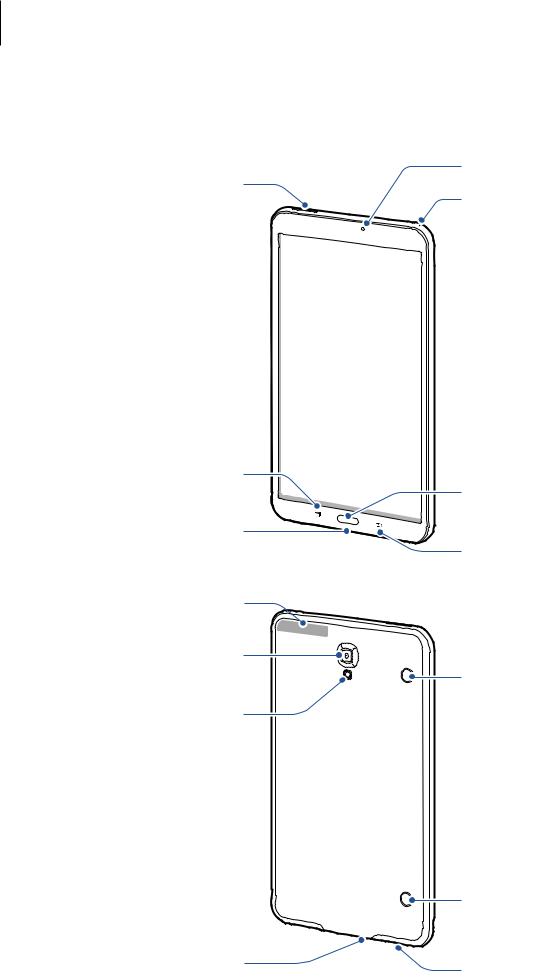
Getting started
Device layout
Light sensor
Speaker
Microphone

 Front camera
Front camera

 Power button
Power button

 Volume button
Volume button
Touch screen 

 IrLED
IrLED

 Memory card slot
Memory card slot
Recent apps button
Home button
Multipurpose jack
Back button
GPS antenna
Rear camera
Push clip
Flash
|
Push clip |
Headset jack |
Speaker |
|
8

Getting started
•Do not cover the antenna area with your hands or other objects. This may cause connectivity problems or drain the battery.
•Using a Samsung-approved screen protector is recommended. Unapproved screen protectors may cause the sensors to malfunction.
•Do not allow water to contact the touch screen. The touch screen may malfunction in humid conditions or when exposed to water.
Buttons
Button |
Function |
|||
|
|
Power |
• |
Press and hold to turn the device on or off. |
|
|
• |
Press to turn on or lock the screen. |
|
|
|
|
||
|
|
|
|
|
|
|
|
• |
Tap to open the list of recent apps. |
|
|
Recent apps |
• |
Tap and hold to access additional options for the current |
|
|
|||
|
|
|
|
screen. |
|
|
|
|
|
|
|
|
• |
Press to turn on the screen while the screen is locked. |
|
|
Home |
• |
Press to return to the Home screen. |
|
|
• |
Press twice to launch S Voice. |
|
|
|
|
||
|
|
|
• |
Press and hold to launch Google. |
|
|
|
|
|
|
|
Back |
• |
Tap to return to the previous screen. |
|
|
|||
|
|
|
|
|
|
|
Volume |
• |
Press to adjust the device volume. |
|
|
|
|
|
9
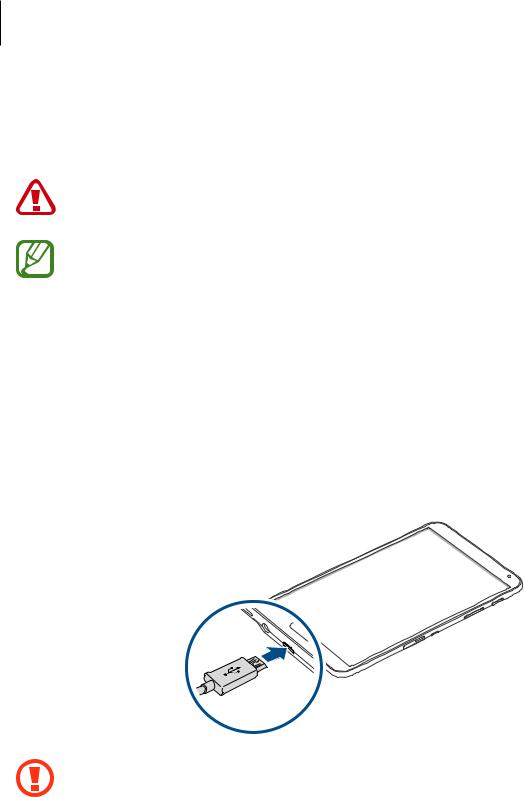
Getting started
Charging the battery
Use the charger to charge the battery before using it for the first time.
Use only Samsung-approved chargers and cables. Unapproved chargers or cables can cause the battery to explode or damage the device.
•When the battery power is low, the battery icon appears empty.
•If the battery is completely discharged, the device cannot be turned on immediately when the charger is connected. Allow a depleted battery to charge for a few minutes before turning on the device.
•If you use multiple apps at once, network apps, or apps that need a connection to another device, the battery will drain quickly. To avoid disconnecting from the network or losing power during a data transfer, always use these apps after fully charging the battery.
Connect the USB cable to the USB power adaptor and then plug the end of the USB cable into the multipurpose jack.
Connecting the charger improperly may cause serious damage to the device. Any damage caused by misuse is not covered by the warranty.
10

Getting started
•The device can be used while it is charging, but it may take longer to fully charge the battery.
•If the device receives an unstable power supply while charging, the touch screen may not function. If this happens, unplug the charger from the device.
•While charging, the device may heat up. This is normal and should not affect the device’s lifespan or performance. If the battery gets hotter than usual, the charger may stop charging.
•If the device is not charging properly, take the device and the charger to a Samsung Service Centre.
After fully charging, disconnect the device from the charger. First unplug the charger from the device, and then unplug it from the electric socket.
To save energy, unplug the charger when not in use. The charger does not have a power switch, so you must unplug the charger from the electric socket when not in use to avoid wasting power. The charger should remain close to the electric socket and easily accessible while charging.
Reducing the battery consumption
Your device provides options that help you save the battery power. By customising these options and deactivating features in the background, you can use the device longer between charges:
•When you are not using the device, switch to sleep mode by pressing the Power button.
•Close unnecessary apps using the task manager.
•Deactivate the Bluetooth feature.
•Deactivate the Wi-Fi feature.
•Deactivate auto-syncing of apps.
•Decrease the backlight time.
•Decrease the screen brightness.
11
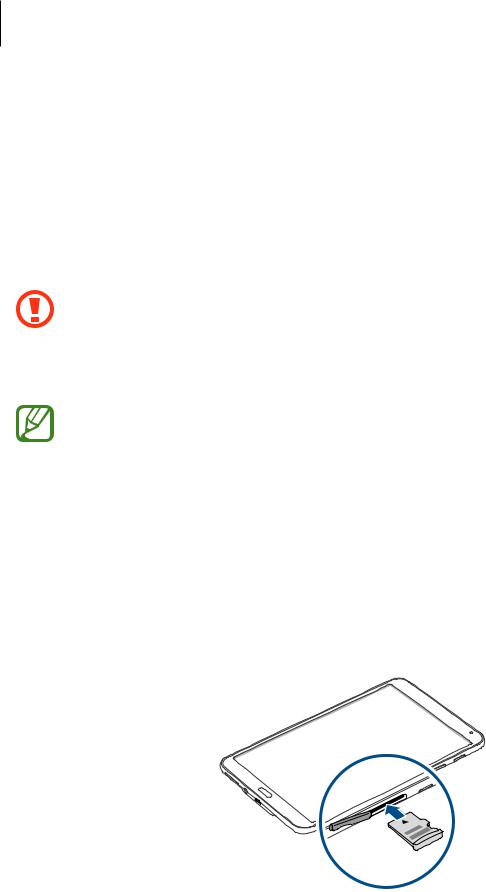
Getting started
Using a memory card
Installing a memory card
Your device accepts memory cards with maximum capacities of 128 GB. Depending on the memory card manufacturer and type, some memory cards may not be compatible with your device.
1
2
•Some memory cards may not be fully compatible with the device. Using an incompatible card may damage the device or the memory card, or corrupt the data stored in it.
•Use caution to insert the memory card right-side up.
•The device supports the FAT and the exFAT file systems for memory cards. When inserting a card formatted in a different file system, the device asks to reformat the memory card.
•Frequent writing and erasing of data shortens the lifespan of memory cards.
•When inserting a memory card into the device, the memory card’s file directory appears in the My Files →SD card folder.
Open the cover of the memory card slot.
Insert a memory card with the gold-coloured contacts facing downwards.
3
4
Push the memory card into the slot until it locks in place. Close the cover of the memory card slot.
12

Getting started
Removing the memory card
Before removing the memory card, first unmount it for safe removal. On the Home screen, tap
 →Settings →General →Storage →Unmount SD card.
→Settings →General →Storage →Unmount SD card.
1
2
3
Open the cover of the memory card slot.
Push the memory card until it disengages from the device, and then pull it out.
Close the cover of the memory card slot.
Do not remove the memory card while the device is transferring or accessing information. Doing so can cause data to be lost or corrupted or can damage to the memory card or device. Samsung is not responsible for losses that result from the misuse of damaged memory cards, including the loss of data.
Formatting the memory card
A memory card formatted on a computer may not be compatible with the device. Format the memory card on the device.
On the Home screen, tap  →Settings →General →Storage →Format SD card → Format SD card →Erase everything.
→Settings →General →Storage →Format SD card → Format SD card →Erase everything.
Before formatting the memory card, remember to make backup copies of all important data stored in the device. The manufacturer’s warranty does not cover loss of data resulting from user actions.
13

Getting started
Turning the device on and off
Press and hold the Power button for a few seconds to turn on the device.
When you turn on your device for the first time or after performing a data reset, follow the onscreen instructions to set up your device.
To turn off the device, press and hold the Power button, and then tap Power off.
Follow all posted warnings and directions from authorised personnel in areas where the use of wireless devices is restricted, such as aeroplanes and hospitals.
14

Getting started
Locking and unlocking the screen
Pressing the Power button turns off the screen and locks it. Also, the screen turns off and automatically locks if the device is not used for a specified period.
To unlock the screen, press the Power button or the Home button and flick your finger in any direction within the unlock screen area.
You can change the unlock code to unlock the screen. Refer to Changing the screen lock method for more information.
15

Basics
Using the touch screen
• Do not allow the touch screen to come into contact with other electrical devices. Electrostatic discharges can cause the touch screen to malfunction.
•To avoid damaging the touch screen, do not tap it with anything sharp or apply excessive pressure to it with your fingertips.
•The device may not recognise touch inputs close to the edges of the screen, which are outside of the touch input area.
•Leaving the touch screen idle for extended periods may result in afterimages (screen burn-in) or ghosting. Turn off the touch screen when you do not use the device.
•It is recommended to use fingers when you use the touch screen.
Tapping
To open an app, to select a menu item, to press an on-screen button, or to enter a character using the keyboard on the screen, tap it with a finger.
16

Basics
Tapping and holding
Tap and hold an item or the screen for more than 2 seconds to access available options.
Dragging
To move an item, tap and hold it and drag it to the target position.
17

Basics
Double-tapping
Double-tap on a webpage or image to zoom in. Double-tap again to return.
Flicking
Flick left or right on the Home screen or the Apps screen to see another panel. Flick up or down to scroll through a webpage or a list of items, such as contacts.
18

Basics
Spreading and pinching
Spread two fingers apart on a webpage, map, or image to zoom in a part. Pinch to zoom out.
19
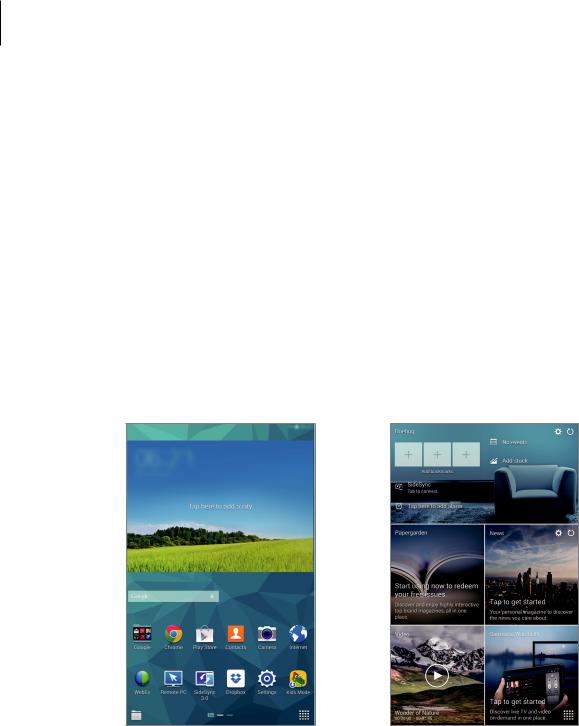
Basics
Home screen layout
Home screen
The Home screen is the starting point for accessing all of the device’s features. The Home screen has two different kinds of panels. The Classic Home screen panel displays widgets, shortcuts to apps, and more, and the Content Home screen panel displays Content widgets. Widgets are small apps that launch specific app functions to provide information and convenient access on your Home screen.
To view other panels, scroll left or right, or tap one of the screen indicators at the bottom of the screen. To customise the Home screen, refer to Managing the Classic Home screen or Managing the Content Home screen.
<Classic Home screen> |
<Content Home screen> |
20
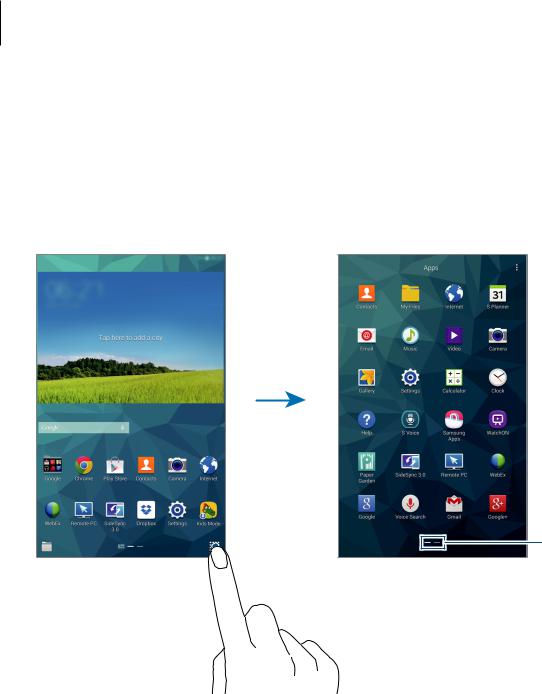
Basics
Apps screen
The Apps screen displays icons for all apps, including newly installed apps.
On the Home screen, tap  to open the Apps screen. To view other panels, scroll left or right, or select a screen indicator at the bottom of the screen. To customise the Apps screen, refer to Managing the Apps screen.
to open the Apps screen. To view other panels, scroll left or right, or select a screen indicator at the bottom of the screen. To customise the Apps screen, refer to Managing the Apps screen.
 Access additional options.
Access additional options.
 An app
An app
Screen indicators
21

Basics
Indicator icons
Indicator icons appear on the status bar at the top of the screen. The icons listed in the table below are most common.
The status bar may not appear at the top of the screen in some apps. To display the status bar, drag down from the top of the screen.
Icon Meaning
Wi-Fi connected
Bluetooth feature activated
GPS activated
Smart stay or smart pause feature activated
Synced with the web
Connected to computer
Alarm activated
Mute mode activated
Vibration mode activated
Flight mode activated
Error occurred or caution required
Battery power level
22

Basics
Notifications and quick setting panels
Using the notifications panel
When you receive new notifications, such as messages, indicator icons appear on the status bar. To see more information about the icons, open the notifications panel and view the details.
To open the notifications panel, drag the status bar downwards.
To close the notifications panel, drag the bar from the bottom of the screen upwards.
23
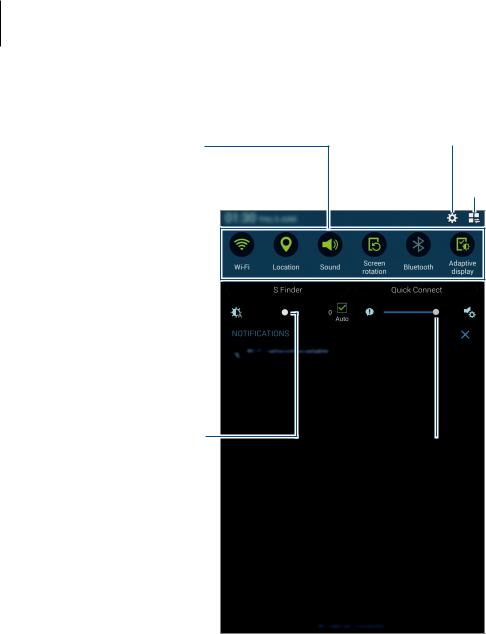
Basics
You can use the following functions on the notifications panel.
Activate or deactivate options.
Tap and hold options to view more detailed settings.
Launch S Finder. 
Tap a notification  and perform various
and perform various
actions.
Adjust the brightness.
 Launch Settings.
Launch Settings.
 View all quick setting buttons.
View all quick setting buttons.
 Launch Quick
Launch Quick
connect.
 Clear all notifications.
Clear all notifications.
 Adjust the volume.
Adjust the volume.
Rearranging quick setting buttons
To rearrange quick setting buttons on the notifications panel, tap  →
→ , tap and hold an item, and then drag the item to another location.
, tap and hold an item, and then drag the item to another location.
24

Basics
Using the quick setting panel
You can activate or deactivate some features on the notifications panel. To activate or deactivate more features, open the quick setting panel.
To open the quick setting panel, drag the status bar downwards with two fingers. Alternatively, tap  on the notifications panel.
on the notifications panel.
To close the quick setting panel, drag the bar from the bottom of the screen upwards.
Tap the following options to activate or deactivate them. You can view more detailed settings if you tap and hold a button.
•Wi-Fi: Refer to Wi-Fi for more information.
•Location: Refer to Location for more information.
•Sound / Vibrate / Mute: Select a sound mode.
•Screen rotation: Allow or prevent the interface from rotating when you rotate the device.
Some apps do not allow screen rotation.
25

Basics
•Bluetooth: Refer to Bluetooth for more information.
•Adapt display: When you activate this feature, the display is automatically optimised for various apps.
•U. power saving: Refer to Ultra power saving mode for more information.
•Multi window: Refer to Multi window for more information.
•Toolbox: Refer to Toolbox for more information.
•Screen Mirroring: Refer to Screen Mirroring for more information.
•Sync: When you activated this feature, the device automatically sync apps, such as calendar or email.
•Reading mode: When you activate this feature, the device helps protect your eyes when reading at night.
•Smart stay: When you activate this feature, the screen stays on as long as you look at it.
•Smart pause: When you activate this feature, playback pauses when you look away from the screen.
•Power saving: Refer to Power saving feature for more information.
•Blocking mode: Refer to Blocking mode for more information.
•Flight mode: Refer to Flight mode for more information.
•Private mode: Refer to Private mode for more information.
•Touch sensitivity: Refer to Increasing touch screen sensitivity for more information.
Opening apps
On the Home screen or the Apps screen, select an app icon to open it.
To open the list of recently-used apps, tap  and select an app icon to open.
and select an app icon to open.
Closing an app
Tap  →Task manager, and then tap End next to an app to close it. To close all running apps, tap End all. Alternatively, tap
→Task manager, and then tap End next to an app to close it. To close all running apps, tap End all. Alternatively, tap  →Close all.
→Close all.
26

Basics
Installing or uninstalling apps
Samsung Apps
Use this app to purchase and download apps.
Tap Samsung Apps on the Apps screen.
This app may not be available depending on the region or service provider.
Installing apps
Browse apps by category or tap  to search for a keyword.
to search for a keyword.
Select an app to view information about it. To download free apps, tap Free. To purchase and download apps where charges apply, tap the button that shows the app’s price.
To change the auto update settings, tap  →Settings →Auto update apps, and then select an option.
→Settings →Auto update apps, and then select an option.
Play Store
Use this app to purchase and download apps.
Tap Play Store on the Apps screen.
Installing apps
Browse apps by category or tap  to search for a keyword.
to search for a keyword.
Select an app to view information about it. To download free apps, tap INSTALL. To purchase and download apps where charges apply, tap the price and follow the on-screen instructions.
To change the auto update settings, tap  →SETTINGS →Auto-update apps, and then select an option.
→SETTINGS →Auto-update apps, and then select an option.
27

Basics
Downloading suggested apps
You can view and download dedicated Galaxy device apps.
On the Classic Home screen, tap the GALAXY Essentials widget or the GALAXY Gifts widget, and then tap  next to an app.
next to an app.
To download all apps in the list, tap Download all.
Managing apps
Uninstalling or disabling apps
To disable default apps, open the Apps screen, tap  →Uninstall/Disable apps.
→Uninstall/Disable apps.  appears on the apps that you can disable. Select an app and tap Disable.
appears on the apps that you can disable. Select an app and tap Disable.
To uninstall downloaded apps, open the Apps screen, tap  →Downloaded apps → Uninstall. Alternatively, on the Apps screen, tap Settings →Applications →Application manager, select an app, and then tap Uninstall.
→Downloaded apps → Uninstall. Alternatively, on the Apps screen, tap Settings →Applications →Application manager, select an app, and then tap Uninstall.
Enabling apps
On the Apps screen, tap  →Show disabled apps, select apps, and then tap Done.
→Show disabled apps, select apps, and then tap Done.
Alternatively, on the Apps screen, tap Settings →Applications →Application manager, scroll to DISABLED, select an app, and then tap Enable.
•Hiding apps: Hide apps in the Apps screen only. You can continue to use hidden apps.
•Disabling apps: Disable selected default apps that cannot be uninstalled from the device. You cannot use disabled apps.
•Uninstalling apps: Uninstall downloaded apps.
28
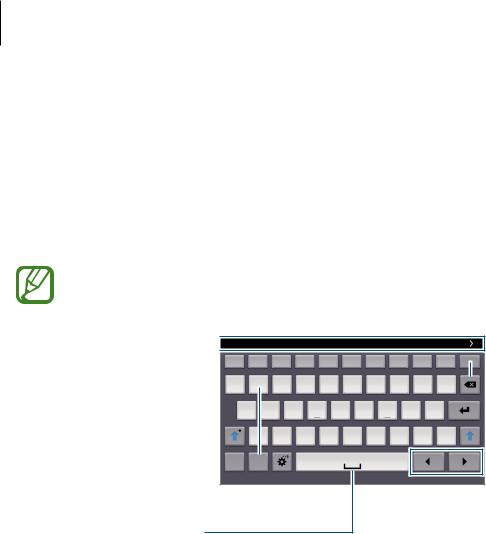
Basics
Entering text
Keyboard layout
A keyboard appears automatically when you enter text to send messages, create memos, and more.
Text entry is not supported in some languages. To enter text, you must change the input language to one of the supported languages.
Suggested keywords 
Enter punctuation marks. 
Enter uppercase. For all  caps, tap it twice.
caps, tap it twice.
Change the keyboard  settings.
settings.
Enter a space.
 Delete a preceding character.
Delete a preceding character.
 Break to the next line.
Break to the next line.
 Move the cursor.
Move the cursor.
Changing the input language
Tap  →Select input languages, and then select the languages to use. If you select two or more languages, you can switch between the input languages by sliding the space key left or right.
→Select input languages, and then select the languages to use. If you select two or more languages, you can switch between the input languages by sliding the space key left or right.
29
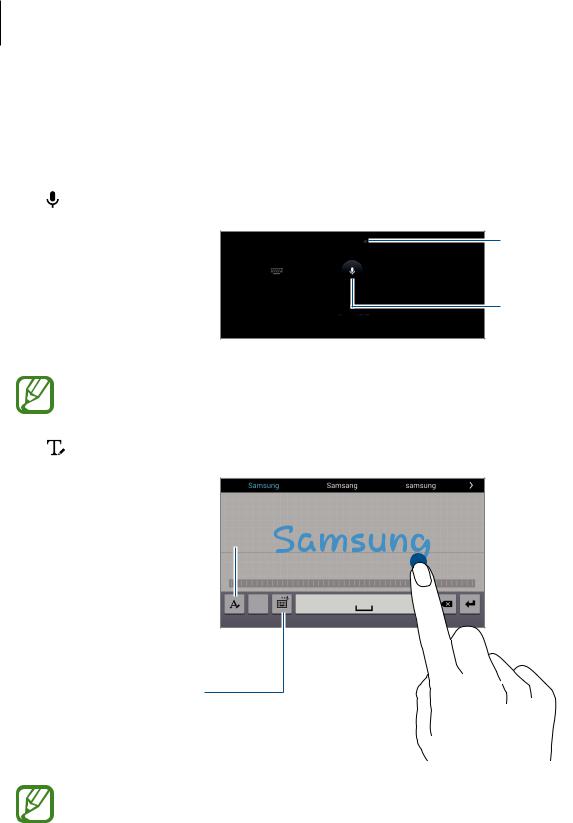
Basics
Using additional keyboard functions
Tap and hold  to use various functions. Other icons may appear instead of
to use various functions. Other icons may appear instead of  depending on the last function that was used.
depending on the last function that was used.
• |
: Enter text by voice. |
Change the language.
Open the keyboard. 
Start or pause entering text by voice.
Ensure that the Wi-Fi network is connected before using this feature.
• |
: Switch to handwriting mode. |
Switch between number  mode and character
mode and character
mode.
Switch to the standard keyboard.
This feature may not be available depending on the region or service provider.
30
